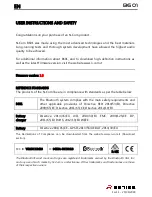
MAN-79
To reach the max jet , unscrew the central plug on the float chamber (see fig. 4), or
disassemble the float chamber itself.
As anticipated just above, there is no clear distinction among the areas of
influence of the various components, as they interact and influence each other.
Generally the max jet affects not only the carburation at max open throttle but
also the whole mid-range carburation, even if less sensibly vs. the needle position;
therefore the needle position slightly influences also the carburation at wide open
throttle.
In the same way, when the throttle is slightly opened, the effects of the min jet
and the air screw overlap with conical needle position effects.
To properly adjust the carburetion according to the ambient conditions, we are
giving some indicative parameters to adapt the max. jet size as a function of the
variation of the ambient temperature and the altitude at which the engine is
operating.
As you know the carburetion, so the exact fuel quantity to be mixed to a given
quantity of air, is influenced by atmospheric factors, such as temperature and
pressure. The more the temperature drops, the more the air density increases and
consequently, there will be more molecules of gas in the same volume taken in by
the engine. As the carburettor mixes always the same fuel quantity, this would be
insufficient and the carb. will provide a leaner mixture. When operating with a
leaner carburetion, the engine runs the following risks: overheating, insufficient
lubrication, detonation, seizure; this is the
reason why the carb. setting must be
adjusted by increasing the max jet by about 2 points for every 5°C. external
temperature drop.
Of course, on the contrary, the more the temperature rises, the more the
carburetion becomes richer and gives origin to less critical consequences than the
ones experienced with a leaner carburetion. So in this case also, it is suggested to
optimize the carb. setting by decreasing the max. jet size by about 2 points for
every 5°C external temperature increase.
The variation of the atmospheric pressure, which is significant when varying the
altitude, gives origin to the same phenomenon; by decreasing the altitude, the
atmospheric pressure increases, consequently in the same air volume taken in by
the engine, more molecules of gas are present. Therefore, in this case too, a carb.
adjustment is required, we suggest to increase the max jet size by approx. 2-3
points for every 350m altitude decreasing.
On the contrary, by increasing the altitude it is necessary to reduce the max. jet
size by about 2-3 points for every 350m altitude increasing.
13



































